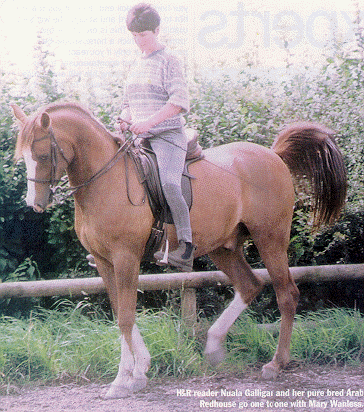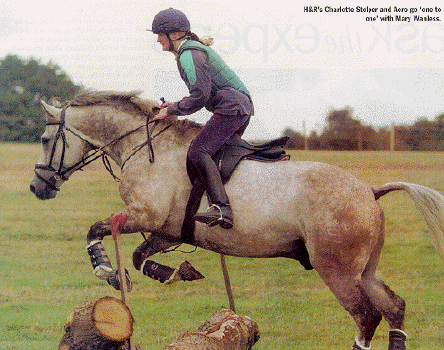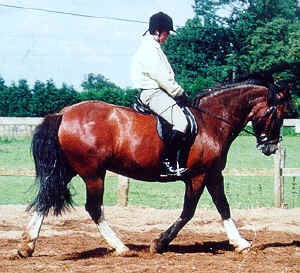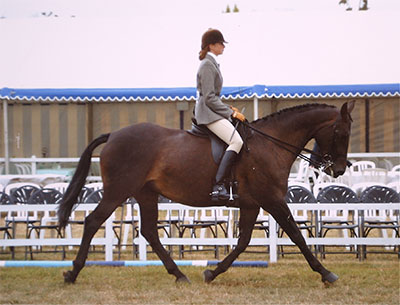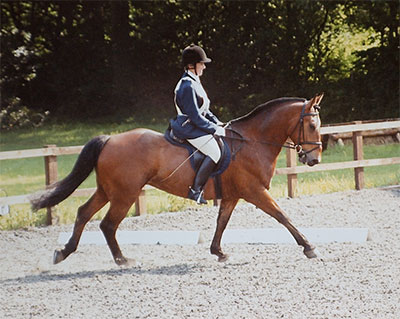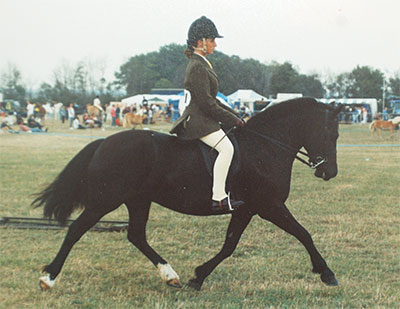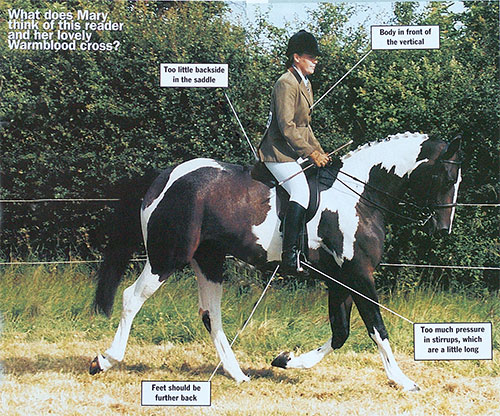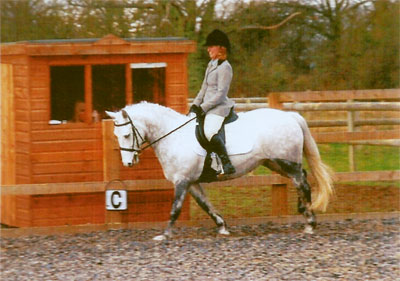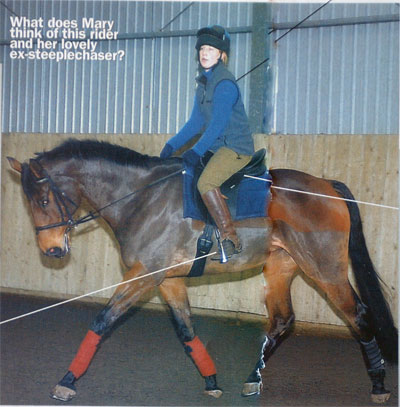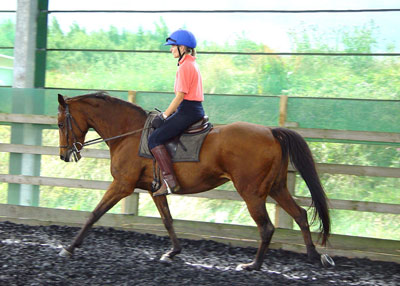RWYM
ARTICLE 32
 This photograph has been sent in by a Swedish reader, and it shows her New Forest/Haflinger pony, who she sadly had to have put down towards the end of last year, at only sixteen. She tells me that she ‘loved to ride him and found him lazy but very responsive’. She had been told that ‘the position of his neck made it impossible for him to use his back in a correct way’, and she would especially like to know if I consider that this was indeed the case.
This photograph has been sent in by a Swedish reader, and it shows her New Forest/Haflinger pony, who she sadly had to have put down towards the end of last year, at only sixteen. She tells me that she ‘loved to ride him and found him lazy but very responsive’. She had been told that ‘the position of his neck made it impossible for him to use his back in a correct way’, and she would especially like to know if I consider that this was indeed the case.
Although the photograph only shows her in walk, she is doing a good job, and the pony is beginning to come up through his back and reach into the rein quite well. To my mind, she has gone quite some way towards defying her teacher’s prognosis!
The picture would be improved by a more profound reach – if we could elongate his spine all the way from his tail to his poll we would get more the effect of him being hung from this topline. (Think of it like a horse-shaped coat hanger.) However, the picture shows a much better attempt than many to bring the horse into carriage, and the rider is at least attempting to bring his back up instead of just trying to get his head down.
Conformation can easily become the justification for why a horse does not appear to work well. Whilst it may indeed prevent a horse from doing upper level work and showing a high degree of collection, it is rarely if ever a reason for the horse not coming ‘through’ into carriage.
I work from the premise that every horse is capable of showing the biomechanics of correct movement in his body. This may not metamorphose him into a Grand Prix dressage horse, but it will make even common, badly put together horses look fantastic. The uninhibited passage of energy from the horse’s hind legs over his croup, back, and neck to the poll makes his conformation faults appear to disappear, and can – if you are a dealer who knows how to do this well – make you a lot of money!
There are two reasons that stop horses ‘coming through’ like this. One (to put it bluntly) is lack of rider skill. However, you should not let this hang over you like a death sentence, for it is only a matter of knowing how. The problem is that the ‘how’ is not so easy to uncover, and if you do uncover it, your learning process will be like a journey that takes you from A to B to C to D etc. and not directly from A to X.
Each step you take will be significant, and it will affect both you and your horse profoundly. But it does not turn you into the finished product (if there is such a thing, which I doubt). The learning process becomes like a journey, in which you reach a new horizon only to discover that it is not the top of the mountain. Suddenly, you are faced with a new vista that was unimaginable before. This means that when you decide that you have ‘arrived’, you will soon be knocked off your pedestal!
The second reason can actually be more subtle and difficult. Many horses (as well as people) have physical limitations that are not based on their conformation, but which stop them from performing as they should. Sometimes bodyworkers (i.e. chiropractors, massage therapists and others) can get to the bottom of the problem, and sometimes they can’t.
These limitations can prove elusive and expensive, and many of them are based around fascia. This is the skin which surrounds each muscle and organ – you see it clearly around the muscles on a chicken leg. It can bunch together rather like cling film. But just as you complain when your partner steals the bedclothes, so the body complains in the places where fascia is being pulled away from, and not in the places it is being pulled towards.
Thus physical limitations vary from the extremely subtle to the blindingly obvious. Our rider, for instance, tells me that ‘Due to a fall from a horse some years ago I have a back problem called spondylolisthesis which causes me some pain, especially when hollowing the back.’ Here, at least, she knows the whys and wherefores of the issue, and she has presumably had good medical help – although chiropractors and osteopaths etc. are often more helpful with these issues than doctors. Even one practitioner can have considerably more success than another trained in the same discipline. (We tend to forget this, even though it is obvious that not all riding teachers are equally skilful.)
Our rider also says ‘ Another of my problems is that I find it difficult to get my lower leg back in the right position. When rising to the trot I tend to get all my weight on the outside of my feet and that gives me pain on the outside of my ankles and knees.’
This is an interesting one. We can see from the photograph that her feet are an issue. The heel is higher than the toe, and the whole foot looks ‘bunched up’, as if she might be curling her toes. She is not aligned with the heel beneath the hip, and a good arrowhead shape to the thigh and calf. She looks to be a naturally high tone person, and this is helping her to support her body weight well despite the poor alignment. I think she has achieved this good carriage by being ‘plugged in’ well (so that her backside does not make extraneous movements over and above the movements of the saddle and the horse’s back). Also, her bear down (in which the rider uses her abdominal muscles as you do when clearing your throat) works well, and is certainly stronger than the hold on the rein.
Once the rider has enough tone and strength to organise these basics (and this can be quite a significant part of your journey) it works well to think more about muscle chains. The most important muscle chains in the horse run from each hind leg, over the croup, under the panels of the saddle, and up each side of the crest to the ears. In people, the muscle chain that I call ‘externals’ runs from under the armpit down the sides of the ribcage and the outside of the pelvis to continue down the outside of the thigh and calf to the ankle.
I suspect that our rider’s problems with her knees and ankles lie in the chain of externals, and that she will eventually find that the fix originates much higher up in the chain, somewhere in her rib cage. I say eventually, because in my experience, this is the kind of issue that only gets resolved when you are well along in that journey of learning.
Until then, our rider needs to think about keeping her inside thigh and knee on the saddle, with her calf more away form the horse. It is a mistake for her to think of ‘wrapping her lower legs around him’. She also needs to spread her weight evenly from big toe to little toe, with the sole of her foot flat and her toe nails lifted towards the top of her boots. But however hard she works with this, will power and obedience will probably have limited effect. The change will not ‘click’ into place until she gets right to the root of the problem.
When she discovers this she will realise that her previous attempts to solve the problem were largely in vain because she was grappling all along with its symptom and not its cause. Convoluted issues like this mean that the path of the learning process is rarely straightforward, and if you want to enjoy your riding, working out how it works has to become the fun of it. This is the journey, and it’s all there is. Just longing to arrive dooms you to misery.
In riding, as in life, we all have our cross to bear. We and our horses are rarely the ideal size and shape, but these limitations are much more overcome-able than most people realise. Added to them are the injuries we know we have, and also the dysfunctions we don’t really know we have. A rider requires a very functional body to do upper level work well (although it has to be said that disabled riders who have some of the essential pieces in place can do fantastic work., and put us all to shame). When a muscle chain suddenly begins to work well you realise the power of fitting together links that had been severed. A small change has profound consequences, for you can’t do much with a broken chain.
Meanwhile, our rider gets to bemoan not her broken muscle chains, but that she has ‘no horse and nowhere to ride’. She misses her pony loads, she tells me, but also says that it would cheer her up to have him featured in a ‘1 to 1’. I hope it really has, and that another lovely horse finds his way into her life very soon.


